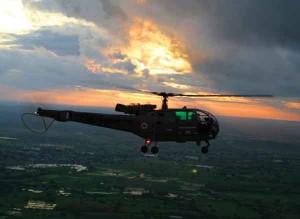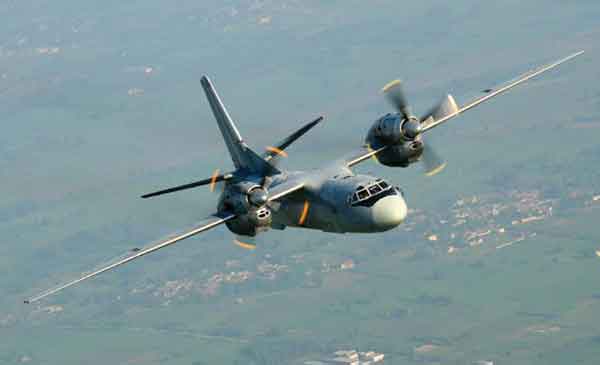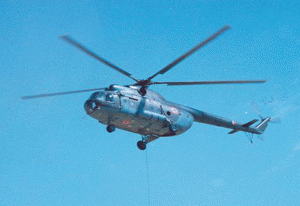The Mi-8 and the AN-32 were the main ‘workhorses’ in Operation Pawan in Sri Lanka. The Mi-8 fleet flew well over 35,000 sorties lifting over 100,000 troops and 5,700 tonnes of load. Similarly, the AN-32 fleet flew more than 6,200 sorties lifting over 150,000 troops and 8,400 tonnes of load. This air effort was augmented by the IL-76, AN-12 and HS-748 in the fixed wing category and by the Mi-17 and Chetak in the rotary wing category. The efforts by these fixed winged aircraft amounted to carrying out over 800 sorties lifting 24,000 troops and 3,900 tonnes of load. Similarly, the rotary wing augmentation contributed towards flying over 500 sorties lifting 600 troops and 25 tonnes of load. A total of 500 sorties were flown by Akbar during these operations. Towards PR/IRLS tasks in this operation, the Canberra and Jaguars flew 107 sorties which included ten sorties by night.
Helicopter operations during the involvement of the Indian Peace Keeping Force (IPKF) in Sri Lanka can be divided into two phases. The first phase, from October 10 to 31, 1987, merits special attention. In this phase, the Liberation of Tamil Tigers Elam (LTTE) fought more in conventional terms. As the LTTE realized the defeat looming ahead, it switched to classic low intensity guerrilla warfare. On October 05, 1987, when 12 LTTE personnel committed suicide by consuming cyanide while in custody of the SLA, it was evident that the LTTE and the IPKF were on a collision course. The general atmosphere in the aftermath of this mass suicide became very tense. Political initiatives had not been able to resolve the issues or convince the LTTE that the IPKF would be able to look after their interests. The LTTE decided to take up arms against the IPKF, which had been inducted only three months earlier to bring about a peaceful resolution to the conflict. In a series of incidents, Indian soldiers began suffering casualties due to sniper fire and mines. The LTTE used claymore mines and Improved Explosive Devices (lEDs) to blow up vehicles and tanks. Hand grenades and other explosives were also thrown at isolated IPKF posts.
As the LTTE realized the defeat looming ahead, it switched to classic low intensity guerrilla warfare.
It became evident that the present strength of one Infantry Division was over-stretched and would not be able to cope with the situation. In fact, at one stage, even Jaffna airfield, the main lifeline of the IPKF, was insecure. It was, therefore, decided to substantially augment the IPKF. From October 03 to 05, 1987, a round-the-clock airlift was organised for the induction of 340 (Ind) Brigade Ex-Trivandrum and 36 Infantry Division Ex-Gwalior.
On October 09, 1987, when the Chief of the Army Staff, General Sunderji visited HQ 54 Infantry Division at Jaffna for a first hand assessment of the situation, he ordered immediate offensive action against the LTTE as well as the induction of additional troops.
On October 10/11, 1987, the Jaffna Operations commenced as planned and the concept of operation was:
- Capture Jaffna town by employing maximum resources
- Simultaneously seal off the Northern peninsula and cut off land and sea routes
- After clearing Jaffna town, clear the outlying areas and remaining peninsula up to Elephant Pass and the islands
- Destroy militants and maintain pressure on Vavuniya, Mannar, Kilinochi and Mullaitivu districts of the Northern Province
The LTTE adopted the following multi-tier system of defence for Jaffna town:-
- Three lines of defence along the major road axes
- An inner line of defence covering the fortified areas of town itself
- Fortified posts on water tanks, rooftops and high trees in built-up areas and along crossroads
- Mobile vans with machine guns
The above operation was to be undertaken in phases with no timeframe laid down. However, when the offensive began on October 10, 1987, there was a great hurry to capture Jaffna town and this put tremendous pressure on the local commanders.
Special Heli-borne Operation (SHBO) — October 11 and12, 1987
When the Jaffna Operations commenced, the total helicopter assets available there were four Mi-8s. On the night of October 11/12, 1987, a night SHBO was planned in conjunction with a multi-pronged advance by other ground units, the objective being the capture of LTTE strongholds near Jaffna University. The SHBO involved heli-lift of two companies – one each of para-Commandos and Sikh Light Infantry in five lifts.
The SHBO could not achieve the planned objectives due to enemy resistance and resultant battle damage. During the third lift, all helicopters came under heavy ground fire. The pilots continued with the mission and pressed on for repeated landings to ensure link-up by the ground forces. This was despite the fact that the helicopters were continuously being fired at and took many direct hits. By the time the last helicopter landed back at Jaffna at midnight, all four Mi-8s had suffered extensive Category B1 battle damages. The pilots, who had made heroic efforts in successfully flying by night, flew their crippled machines back to Jaffna airfield. Fortunately, none of the crew members were injured. The recovery of these helicopters, which entailed main rotor blade changes besides major structural and electrical repairs, was another technical achievement by the IAF. The first helicopter was ready for action on October 19, 1987. Subsequently, a detachment of 11 R&SU was positioned at Jaffna for immediate repairs to the battle-damaged helicopters.
At one stage, even Jaffna airfield, the main lifeline of the IPKF, was insecure.
A thorough post-operation analysis of the above SHBO brought out the following. No joint briefing was carried out for this mission. The Landing Zone (LZ) planned by HQ and marked on its map was different from the one marked on the Task Force Commander’s map. It had been jointly recced in the daytime in a Chetak helicopter by the Task Force Commander (TFC) and the Ground Force Commander (GFC) at 3,000 feet. Unfortunately, the GFC was killed in action that night and the Landing Zone ambiguity was never resolved. HQ insisted that the troops were landed at the wrong Landing Zone while the TFC maintained that his helicopters had landed precisely at the LZ indicated by the GFC during the recce. A joint briefing would certainly have prevented such a situation. The two Landing Zones were at least two kilometres apart although there had been a number of distinctive features besides a linear feature (Jaffna – KKS railway line) for their positive identification separating them.
Other factors that emerged during the post-mission analysis were:-
- The TFC was not aware of the Ground Forces objectives, its defence or any other form of intelligence about it. He was not even aware that the Landing Zone chosen and recced by him and the GFC was, in fact, surrounded by the very objective of our ground forces – the multi-storied University building. The IAF Base Commader at Jaffna at that time, an experienced Mi-8 pilot, somehow did not involve himself at all with the planning and other aspects of this operation and there were serious shortcomings in briefings, tactics and intelligence.
- The approach and take-offs for all five lifts were planned in the same direction. This gave the LTTE enough time to position automatic weapons on the top floor of one of these buildings and direct accurate fire on the helicopters as they came abeam.
- Due to the total lack of dedicated tele-communication, the above helicopter operations were not controlled or even monitored by the Ops Room (AF) of HQ, SAC.
Establishment of Joint Operations & Intelligence Room (AF)
After the above incident, an officer of the rank of Air Commodore was appointed and was directed to coordinate and exercise full operational control on behalf of HQ, SAC over all air operations undertaken in connection with Operation Pawan. The joint operations centre (AF) was suitably staffed and communication with the island bases was established for this purpose. Suitable directives and SOPs were immediately issued to regulate subsequent Mi-8 and Mi-25 operations in Jaffna and elsewhere in Sri Lanka.
Political initiatives had not been able to resolve the issues or convince the LTTE that the IPKF would be able to look after their interests.
The Mi-8 force, now substantially augmented, played an extremely crucial role in the rest of Jaffna operations. In addition to the classic SHBOs, it also carried out a number of ferry missions to heli-lift troops from one axis to another as also across lagoons and islands since the roads/waterways were totally unsafe at that time. The same force simultaneously had to provide operational logistic support also to own troops advancing on a different axis. Operating conditions throughout this phase were most trying.
The qualitative contribution of the Mi-8 to the Jaffna operations cannot be measured in precise terms. Undoubtedly, it had a decisive role and an impact on the conduct and final outcome of operations. During this phase, surface movements were totally denied to own ground forces. The Mi-8s were the only means available for movement/re-deployment of troops, their re-supply and in fact, every other task. During this phase, the limited Mi-8 fleet flew 720 sorties lifting 570 tonnes of load and 6,700 troops.
Tactics employed by the Mi-8s, perforce, had to be suited to the pattern and concept of ground operations. During this phase, ground operations were launched as multi-pronged frontal assaults on Jaffna town employing large forces. The SHBOs planned during this phase, entailed simultaneous heli-landing of at least a company size force. This meant up to four Mi-8 landing within a small zone. Later, ground formation commanders were prevailed upon to plan the induction of smaller groups in order to avoid concentrating too many helicopters in a restricted landing area. This aspect assumed importance as own ground forces started closing in onto Jaffna town and suitable Landing Zones were not easily available. With the lessons of the night of October 11/12 in mind, the helicopter crew was briefed accordingly on routeing, transit height and approach/lift-offs. Experience during this phase of operation, both for our aircrew and ground forces, led to further refinements in tactics. At this stage, use of attack helicopter as escort or to provide suppressive fire was not thought of.
Induction of Mi-25 Gunships
The Mi-25 or Akbar as it is popularly known in the IAF was inducted into the Jaffna operations on October 23, 1987. The first Akbar mission was launched from Jaffna on October 25, with the target as Jaffna jetty. The armament expended in the first mission was rockets and 12.7mm guns. The results were almost immediately apparent because the LTTE was forced to stay away from the roads and waterways. All their movements became restricted to night. LTTE intercepts indicated that they would take cover as soon as the sounds of an Akbar were heard. The use of gunships wrested the initiative from the LTTE who, till then, had total freedom of movement both on the roads and over waterways. Since no other movements by road or waterways were permitted at that time, the identification of targets from the air was relatively easy during this phase. Any visible vehicle/boat was promptly dubbed hostile and effectively engaged by Akbar. A number of search and strike as well as pre-planned sorties were mounted against the LTTE. Targets engaged by the Akbar ranged from small bands of militants to moving vans, tractors and motor cycles. Even speed boats in lagoons and coastal waters were not spared. Pre-planned missions were organized against huts, bunkers, jetties and jungle hide-outs.
 Most of the attacks carried out by Akbar proved deadly and accurate. These included successful attacks on ammunition dumps, warehouse, buildings, boats and vehicles. The mopping up operation commenced only after the capture of Jaffna town. The first mission was launched on November 06, 1987, when four 250kg bombs were dropped in three level passes from 900m AGL. All four bombs hit within 75 metres of the intended target, an LTTE hide-out, and effectively destroyed it. The most successful Akbar mission, however, was over Chavakachcheri on October 28, 1987, in which a strong LTTE hide-out consisting of a large number of barracks was totally destroyed, killing an unspecified number of militants. In November 1987, when mopping up operations were in progress in the Jaffna peninsula, Akbar was very effectively utilised with guns and rockets. The maximum physical damage was inflicted on the LTTE during this phase. In later operations in jungles because of civilian movements of personnel, vehicles and boats, it had become impossible to distinguish militants from civilians.
Most of the attacks carried out by Akbar proved deadly and accurate. These included successful attacks on ammunition dumps, warehouse, buildings, boats and vehicles. The mopping up operation commenced only after the capture of Jaffna town. The first mission was launched on November 06, 1987, when four 250kg bombs were dropped in three level passes from 900m AGL. All four bombs hit within 75 metres of the intended target, an LTTE hide-out, and effectively destroyed it. The most successful Akbar mission, however, was over Chavakachcheri on October 28, 1987, in which a strong LTTE hide-out consisting of a large number of barracks was totally destroyed, killing an unspecified number of militants. In November 1987, when mopping up operations were in progress in the Jaffna peninsula, Akbar was very effectively utilised with guns and rockets. The maximum physical damage was inflicted on the LTTE during this phase. In later operations in jungles because of civilian movements of personnel, vehicles and boats, it had become impossible to distinguish militants from civilians.
When the Jaffna operations commenced, the total helicopter assets available there were four Mi-8s…
The effectiveness of Akbars, particularly in the search and strike role, can be best judged by the radio intercepts and interrogations. The fact that this weapon system forced the LTTE to move only by night is itself, an indication of its effectiveness. This way, it also helped in bringing about a shift in initiative from the LTTE to our ground troops. Besides causing severe physical casualties, this helicopter had tremendous psychological impact on the LTTE. The extensive damage caused to them, particularly to their fortified strongholds, greatly assisted and perhaps hastened the process of forcing the LTTE to abandon Phase I of direct confrontation with the IPKF and switch to Phase II of guerrilla tactics.
PHASE II: November 01, 1987 – March 1990
After the Jaffna operations, the main LTTE cadre dispersed in to the jungles of Vavuniya and Batticaloa Sectors and changed over to guerrilla type of warfare. Their main concept of operating during this phase was to avoid direct confrontation with the IPKF and have no organised resistance. They adopted hit-and-run tactics and planned ambushes using mines and IEDs extensively.
An overall appreciation of the changed situation was carried out by the IPKF, HQ. Based on this, the concept of operations was revised as ‘move out and search out LTTE offensively’ which included cordon and search operations, raids on LTTE hide-outs, ambushes, control measures such as curfews, spot checks, roadblocks and patrolling in selective areas and recovery of arms/ammunition based on information/interrogation.
To meet the above tasks, the level of ground forces was greatly increased during this phase. Also, immediately after the Jaffna operations, there were massive redeployments of units, almost all by air. The orbat of own ground forces during Phase II is given below:-
Four Infantry Divisions with HQs at Palali, Trinco, Vavuniya and Batticaloa as under:-
- 46 Infantry battalion, 3 Commando battalions and 2 regiments of mechanized battalions
- One regiment each of Armoured (T-72) and Artillery (field guns)
- Support units of Engineers, EME, Signals, Supply and Ordnance
Phase II operations were confined mainly to the jungles of Vavuniya with sporadic operations mounted in the Beirut forests of Batticaloa Sector. The LTTE concentrated mainly in the Mullaitivu District which encompassed the towns/settlements of Oddusuddan, Nedukeni and Alampil which are areas consisting of thick tropical jungles with very tall trees (60 – 70 feet) and secondary growth making visual acquisition of targets from the air virtually impossible. There are innumerable jungle tracks and water holes called kulums. The LTTE established large number of training camps in this area.







That is very fascinating, You’re an excessively skilled blogger.
I have joined your rss feed and sit up for looking for extra of your great post.
Additionally, I have shared your site in my social networks
When I originally commented I clicked the “Notify me when new comments are added” checkbox
and now each time a comment is added I get four e-mails with the
same comment. Is there any way you can remove me from that service?
Thanks a lot!
WordPress is designed to integrate with Social Media instruments and companies right out of the creating your Dwelling Enterprise blog on this running a blog platform,
you set it up your self and host it your self.
To make your search for the perfect internet host a little bit easier, here’s an in depth comparison we put together of the most well-liked web hosts available on the market.
Excellent post. I’m going through many of these issues as well..